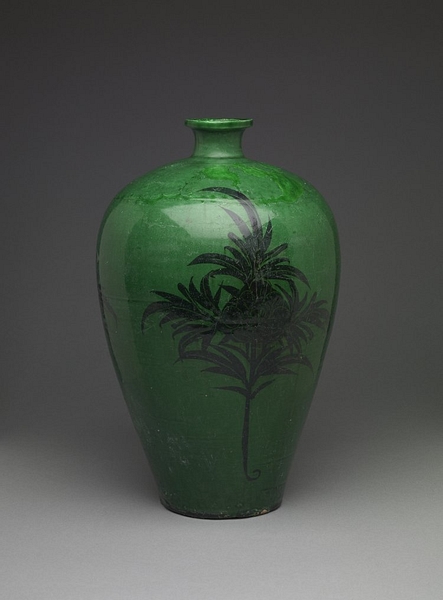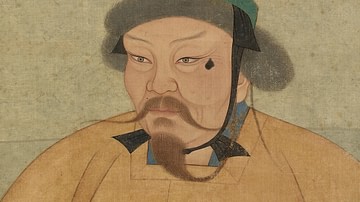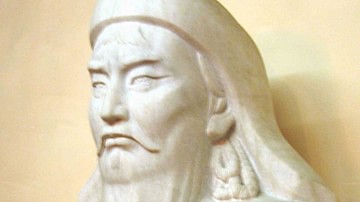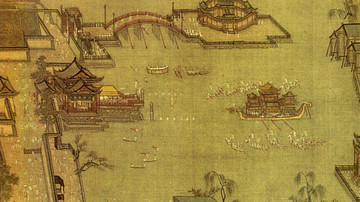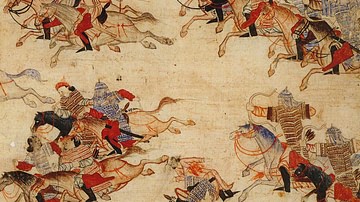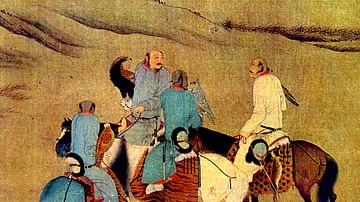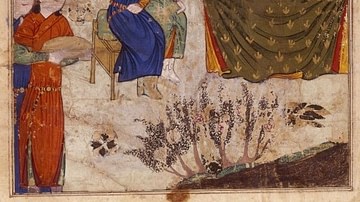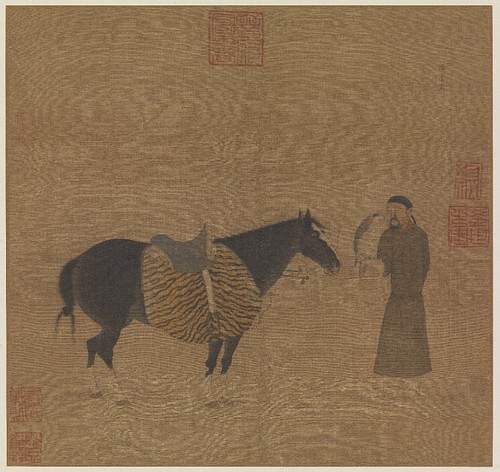
The Jurchen Jin Dynasty (meaning “Golden”) ruled parts of China, Mongolia, and northern Korea from 1115 to 1234 CE. The Jurchen originated from Manchuria, but in conquering the neighbouring Liao empire of the Khitan and parts of Song China, they came to rule the Great Plain of Asia from 1127 CE until their fall at the hands of the Mongols. It is not to be confused with the Chinese Jin dynasty which ruled China from 266 to 316 CE.
Origins & Prosperity
The Jurchen were a subject tribespeople in the north-eastern part of China with the most important clan being the Wanyan. The Jurchen were descendants of both the nomadic Tungus Malgal peoples and the remnants of the defunct Balhae (Parhae) kingdom of Manchuria and northern Korea. They spoke the Tungusic language. Living in small walled towns and villages around the Liao and Sungari rivers, they were hunters and farmers. Those groups near the neighbouring state of China adopted more sophisticated technologies and cultural practices while in more central and northern areas the Jurchen remained closer to their traditional roots. Expert at animal husbandry, the Jurchen specialised in horse breeding, which became a significant source of wealth. By the mid-11th century CE, they exported some 10,000 horses to the Khitan Liao state each year.
The Jurchen were not entirely free, though, and had to pay an irksome annual tribute to their more powerful western neighbours, the Liao state, which usually took the form of furs, falcons, and pearls during the 11th century CE. Relations with the Song dynasty of China were rather a better deal as the Chinese gave annual “gifts” of tea, silver, and silk in order to avoid Jurchen border attacks. The complex relations between the three states often broke out into warfare but trade was also carried out between all three parties. The Jurchen were able to import such necessities as rice, grain, and tea while exporting horses, pearls, and ginseng.
Conquest of the Khitan
In the early 12th century CE the Jurchen began to challenge the regional dominance of the Liao empire and the kingdom of Goryeo (Koryo) in Korea. The whole precarious balance of treaties and tributes in East Asia was about to collapse. An 1103 CE revolt eventually led to a war with Goryeo, when the Jurchen were led by the Wanyan leader Yingge. Winning round one, the Jurchen then had to face a fightback. In 1107 CE the Koreans sent a specialised army (pyolmuban) of cavalry and infantry led by the general Yun Kwan for the purpose of ridding themselves of this foreign nuisance. Initial victories and the establishment of fortifications by Goryeo did not prevent a resounding defeat in 1109 CE. The horsemanship, archery skills, and great mobility of the Jurchen army proved far superior and an ominous warning of what steppe cavalry might achieve in the region in the coming centuries.
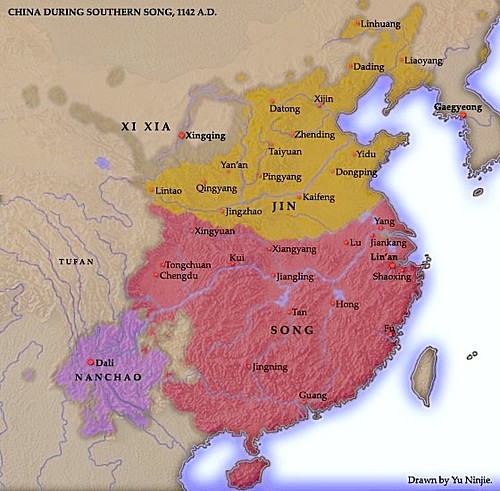
Invasion of Song China
Aguda was succeeded by Emperor Taizong in 1123 CE, and almost immediately he set about expanding his empire. In 1125 CE, realising their former ally the Song were militarily weak, the Jin attacked parts of northern China over the coming year. Even the great general Tong Guan (1054-1126 CE) could not stop the invasion which saw the capital Kaifeng besieged. The emperor Huizong (r. 1100-1126 CE) was captured along with thousands of others, and the Jin acquired a huge swathe of territory down to the Yangtze River. The Song were compelled to pay the Jurchen a massive ransom to avoid any more loss of life. The defeat necessitated the Song court relocate to the Yangtze Valley, and they eventually established a new capital in 1138 CE at Hangzhou (aka Linan) in Zhejiang province. This was the beginning of the Southern Song dynasty. Relations between the Jin dynasty and Song China thereafter remained mostly friendly, with a formal peace treaty signed between the two states in 1142 CE. The weakened Song, once again happy to pay off a dangerous neighbour in tribute rather than engage in more costly wars, sent the Jin silk and silver in huge quantities.
Meanwhile, in Korea, the attack on the Song state motivated the kingdom of Goryeo to send an embassy of submission to the Jin in 1126 CE - the alternative would surely have been full conquest by the Jin state. When the defeated Song appealed to Goryeo for help in getting back their royal family the following year, King Injong of Goryeo politely refused. The Jin were the new power in the region and clearly not to be trifled with.
Government
The Jin capital was at Shangjing (modern Harbin), but in 1153 CE it was moved to Yanjing (modern Beijing) following the takeover of the Liao territory. As with many states which bordered with China, the Jin adopted many Chinese political and cultural practices. China was always seen as the great civilised state in East Asia, and its methods of administration and bureaucracy were effective enough to be copied by newer states like the Jin. The Jurchen also adopted writing characters similar to those in Chinese, although the Jurchen language itself is yet to be deciphered. Some things it did not copy though, and one was the Confucian reverence for officialdom. Jin rulers were not averse to publicly flogging corrupt or inept senior officials, a treatment unheard of in Chinese government.
Culture
The adoption of Chinese ways was certainly not accepted by everyone. There remained die-hard Jurchen tribesmen who wished to preserve their own culture, and this caused a conflict between the two camps of pro-Chinese and traditionalists. In 1161 CE the opponents of sinicisation made their boldest move and assassinated the Jin emperor, Hailingwang. His successor, Emperor Shizong, was compelled to appease the hardliners by promoting the use of the Jurchen language above Chinese. Shizong promoted Jurchen-language schools, ensured Chinese texts were translated and the civil service examinations used Jurchen. The arts also promoted Jurchen culture, especially hunting. Scenes of men with falcons hunting geese and swans were depicted in paintings, on woven textiles, and in jade carvings. Still, by the end of the 12th century CE, Jin rulers very much saw themselves as the inheritors of China's culture now that they had occupied a third of its lands.
Collapse
The nomadic Mongol tribes had been assembled under the leadership of Genghis Khan (r. 1206-1227 CE), and they repeatedly attacked and plundered the Xia and Jin states in the first three decades of the 13th century CE. Attacks came in 1205 and 1209 CE, and then, in 1211 CE the Mongols stepped up their invasion and entered Jin territory with two armies of 50,000 men each. The Jurchen were able to field 300,000 infantry and 150,000 cavalry but the Mongol tactics proved that numbers were not everything. Genghis Kahn would savagely sack a city and then retreat so that the Jin could retake it but then had to deal with the chaos. The tactic was even repeated several times on the same city. One Jin official, Yuan Haowen (1190-1257 CE) wrote the following poem to describe the devastation of the Mongol invasion:
White bones scattered
like tangled hemp,
how soon before mulberry and catalpa
turn to dragon-sands?
I only know north of the river
there is no life:
crumbled houses, scattered chimney smoke
from a few homes.
(in Ebrey, 237)
The Jin were not helped by their own internal problems either. Besides chronic corruption emptying the state coffers and the odd natural disaster in the form of floods, in 1213 CE the emperor, Feidi, was assassinated by a Jin general whose own candidate was himself assassinated only two months afterwards. The Jin rulers were compelled to retreat south and pay tribute to the Great Khan, although they were probably glad to, faced with the stark alternative. It was a respite but worse was to come as the Mongols reattacked in 1215 CE. The Jin state, now nothing more than a province, finally came to an end when it could not withstand another invasion, this time sent by Ogedei Khan, in 1234 CE. It was not an end to the tribe, though, and the nomadic Jurchen continued to raid northern Korea in the 14th and 15th centuries CE. Then, known in this period as the Manchurians, they conquered the peninsula completely in 1636 CE.
